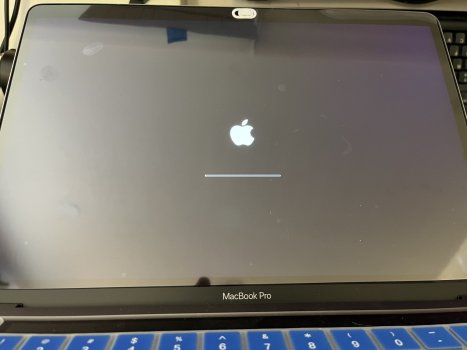I am working on a MacBook Pro (4-TB ports, 2020) that came in able to boot about 1/3 of the way through the progress thermometer. I performed a PRAM reset (it will only chime once; attempts to perform a 2-chime or better reset produce no result; the laptop goes to the boot progress thermometer after the first chime). After the reset, I managed to boot into the recovery environment and perform a disk repair, whereupon it started booting normally. Booted it several times and logged into the client's user profile without issue. That was last night.
I came in this morning, however, and booted it again to make sure that all was well. Instead, I found that the MBP had reverted back to its "boot-one-third-of-the-way" state. Again, I performed a PRAM reset and attempted to log into Recovery Environment but found that device would not do so. I tried connecting a ProToGo16 USB drive and attempted to boot from this but found that, after choosing the USB device, the MBP would only boot about 1/20th of the way through the progress thermometer. Tried this several times; then removed PTG16 and attempted to boot into Recovery Environment but found that the syndrome repeated.
Consulted Apple's knowledge base, which advised me to perform a reinstall of the MacOS (Monterey) but I cannot boot into the Recovery Environment so could not do so.
At this point no matter what is attempted, the system will not boot further than about 1/20th of the boot progress thermometer’s length. After an appreciable time, the screen goes black. The system continues running but screen is black and there's no sign of activity. It remains in this condition until the system is powered down by pressing the power button for 10 seconds.
I can think of nothing else to try. I'm inclined to think that either the storage component or the logic circuitry (or both) are at fault. And due to Apple's decision to embed both storage and RAM into the logic board it doesn't seem to matter which component is at fault. The result is the same; basically a non-functional logic board.
The nearest Apple Store is almost 100 miles from here and I'm wondering, given the severity and intractable nature of the symptoms, whether they wouldn't just come to the same conclusion that I have; that a logic board replacement is called for. The device is well outside its 1-year warranty but could be sent in to an Apple Service Center. Or I could just get another logic board (≈ $500-$850) and replace it.
If anyone out there has seen anything like this and knows of some expedient that could yet be tried, I'd be very grateful. Or if anyone has sent in a similar device in need of a logic board for out-of-warranty service, I'd appreciate knowing what it wound up costing. Apple's support page is understandably vague and I'm trying to figure out what the best route for my client's situation would be.
Thanks in advance for taking the time and energy to read and consider this ... and thanks very much for any advice or insight you may have.
I came in this morning, however, and booted it again to make sure that all was well. Instead, I found that the MBP had reverted back to its "boot-one-third-of-the-way" state. Again, I performed a PRAM reset and attempted to log into Recovery Environment but found that device would not do so. I tried connecting a ProToGo16 USB drive and attempted to boot from this but found that, after choosing the USB device, the MBP would only boot about 1/20th of the way through the progress thermometer. Tried this several times; then removed PTG16 and attempted to boot into Recovery Environment but found that the syndrome repeated.
Consulted Apple's knowledge base, which advised me to perform a reinstall of the MacOS (Monterey) but I cannot boot into the Recovery Environment so could not do so.
At this point no matter what is attempted, the system will not boot further than about 1/20th of the boot progress thermometer’s length. After an appreciable time, the screen goes black. The system continues running but screen is black and there's no sign of activity. It remains in this condition until the system is powered down by pressing the power button for 10 seconds.
I can think of nothing else to try. I'm inclined to think that either the storage component or the logic circuitry (or both) are at fault. And due to Apple's decision to embed both storage and RAM into the logic board it doesn't seem to matter which component is at fault. The result is the same; basically a non-functional logic board.
The nearest Apple Store is almost 100 miles from here and I'm wondering, given the severity and intractable nature of the symptoms, whether they wouldn't just come to the same conclusion that I have; that a logic board replacement is called for. The device is well outside its 1-year warranty but could be sent in to an Apple Service Center. Or I could just get another logic board (≈ $500-$850) and replace it.
If anyone out there has seen anything like this and knows of some expedient that could yet be tried, I'd be very grateful. Or if anyone has sent in a similar device in need of a logic board for out-of-warranty service, I'd appreciate knowing what it wound up costing. Apple's support page is understandably vague and I'm trying to figure out what the best route for my client's situation would be.
Thanks in advance for taking the time and energy to read and consider this ... and thanks very much for any advice or insight you may have.
Attachments
Last edited:


